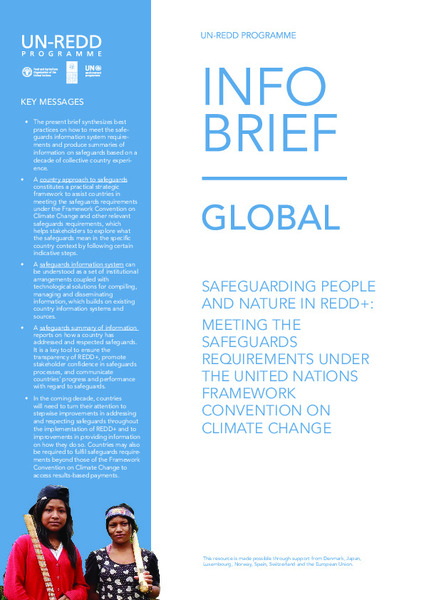| dc.contributor | Ecosystems Division | en_US |
| dc.contributor.author | United Nations Environment Programme | en_US |
| dc.contributor.author | Food and Agriculture Organization of the United Nations | en_US |
| dc.coverage.spatial | Global | en_US |
| dc.date.accessioned | 2024-02-21T11:13:31Z | |
| dc.date.available | 2024-02-21T11:13:31Z | |
| dc.date.issued | 2024-02 | |
| dc.identifier.uri | https://wedocs.unep.org/20.500.11822/44926 | |
| dc.description | The implementation of activities under the REDD+ mechanism has the potential to deliver social and environmental benefits that go beyond the reduction of greenhouse gas emissions, but it may also entail potential risks to people and the environment. Safeguards are principles or measures that aim to protect or to avoid risks (“do no harm”), while promoting benefits (“do good”). Seven safeguards, also known as the “Cancun safeguards”, were agreed for REDD+ at the sixteenth session of the Conference of
the Parties to the United Nations Framework Convention on Climate Change in 2010. | en_US |
| dc.format | pdf | en_US |
| dc.language | English | en_US |
| dc.rights | Public | en_US |
| dc.subject | SAFEGUARD MEASURES | en_US |
| dc.subject | FOREST CONSERVATION | en_US |
| dc.title | Safeguarding People and Nature in REDD+: Meeting the Safeguards Requirements Under the United Nations Framework Convention on Climate Change. UN-REDD Programme Info Brief Global | en_US |
| wd.identifier.sdg | SDG 15 - Life on Land | en_US |
| wd.identifier.sdg | SDG 16 - Peace, Justice and Strong Institutions | en_US |
| wd.topics | Nature Action | en_US |
| wd.identifier.pagesnumber | 16 p. | en_US |


